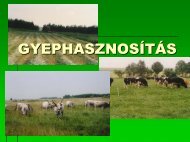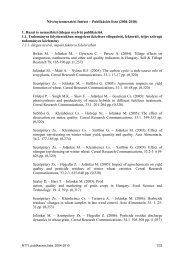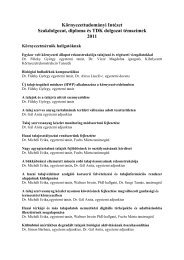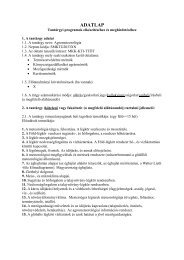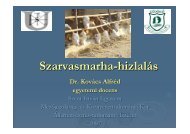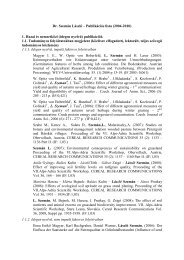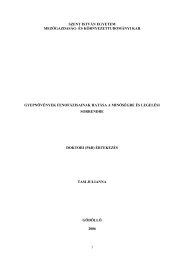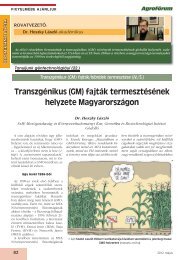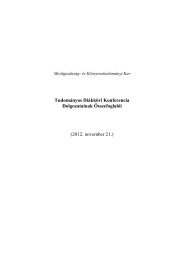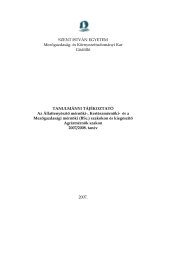Seasonal variations of yolk colour and IgY concentration in natural ...
Seasonal variations of yolk colour and IgY concentration in natural ...
Seasonal variations of yolk colour and IgY concentration in natural ...
- No tags were found...
Create successful ePaper yourself
Turn your PDF publications into a flip-book with our unique Google optimized e-Paper software.
Kiss et al. Nitra 2010. 5mg/egg (Akita et al., 1992). Dur<strong>in</strong>g the lay<strong>in</strong>g <strong>of</strong> eggs, with 20 eggs / month productivity, 2 gantibody can be extracted from a lay<strong>in</strong>g hen per month.Physical <strong>and</strong> chemical characteristics <strong>of</strong> <strong>IgY</strong>:The isoelecronic po<strong>in</strong>t <strong>of</strong> <strong>IgY</strong> is lower than the IgG’s <strong>of</strong> mammals (Polson et al.1980), <strong>IgY</strong> spreads from 5,7-7,6, IgG spreads from 6,1-8,5.After the discovery <strong>of</strong> Fc-fragment, <strong>IgY</strong> is the least hydr<strong>of</strong>ob antibody molecule(Davalos et al, 2000).<strong>IgY</strong> had been studied <strong>in</strong> acidic <strong>and</strong> alkalescent mediums. <strong>IgY</strong> activity decreased <strong>in</strong>mediums with 3,5 or lower pH. The molecule suffers irreversible changes at pH 3 (Shimizu etal., 1988, 1992, 1993). Lösch et al. (1986), Hatta et al. (1993), Lee et al. (2002) came to asimilar conclusion. The rapid drop <strong>in</strong> <strong>IgY</strong>’s activity is caused by the deterioration <strong>of</strong> its Fabregion. In alkalescent mediums, <strong>IgY</strong> molecule doesn’t show drop until pH 11. Accord<strong>in</strong>g tothe writers above, it is still active at pH 12.Proteolitic stability:<strong>IgY</strong> is partly resistant to trips<strong>in</strong> <strong>and</strong> chymotrips<strong>in</strong> digesters, but especially sensitive tothe effects <strong>of</strong> peps<strong>in</strong> digester. In 1993, Hatta <strong>and</strong> his colleagues revealed that after 8 hours,<strong>IgY</strong> loses its activity under the effect <strong>of</strong> peps<strong>in</strong>, but <strong>in</strong> trips<strong>in</strong> <strong>and</strong> chymotrips<strong>in</strong>, it still shows a39-41 % activity. <strong>IgY</strong>’s stablitiy aga<strong>in</strong>st peps<strong>in</strong> largely depends on pH <strong>and</strong> enzym / substratratio. In a medium with a 4,5 or lower pH, both <strong>of</strong> its activities stops (Shimizu, 1998).Temperature <strong>and</strong> pressure stability:<strong>IgY</strong> had been studied on different temperature for different durations. Accord<strong>in</strong>g to theexam<strong>in</strong>ations <strong>of</strong> Shimizu (1992) <strong>and</strong> Hatta (1993), <strong>IgY</strong> molecule is stable between +20 °C<strong>and</strong> +70 °C. A drop can be observed <strong>in</strong> stability below +15 °C <strong>and</strong> over +70 °C. <strong>IgY</strong>denaturises if it’s kept over +75 °C (Chang et al., 1999).It’s <strong>natural</strong> that <strong>in</strong> case <strong>of</strong> biological samples, freez<strong>in</strong>g, li<strong>of</strong>ilization causesdeterioration <strong>in</strong> the quality <strong>and</strong> quantity <strong>of</strong> the matter. Accord<strong>in</strong>g to Shimizu (1988), freez<strong>in</strong>g<strong>and</strong> li<strong>of</strong>ilization has no effect on <strong>IgY</strong>.In 1998, Chansarkar revealed that <strong>IgY</strong>’s activity olny drops after freez<strong>in</strong>g <strong>and</strong>li<strong>of</strong>ilization if it was performed with high salt <strong>and</strong> prote<strong>in</strong> <strong>concentration</strong>. In 2006, Fu came toa similar conclusion, when he studied temperature stability for 15 m<strong>in</strong>utes between 25 <strong>and</strong> 90



